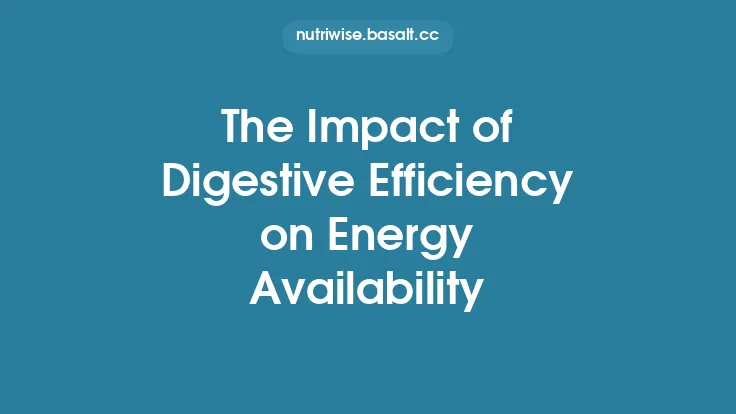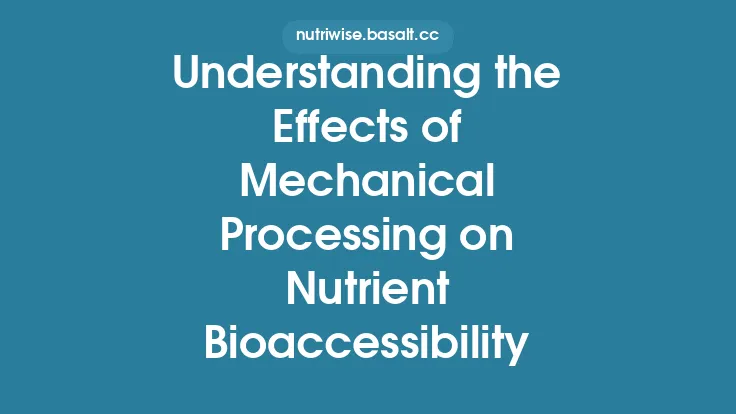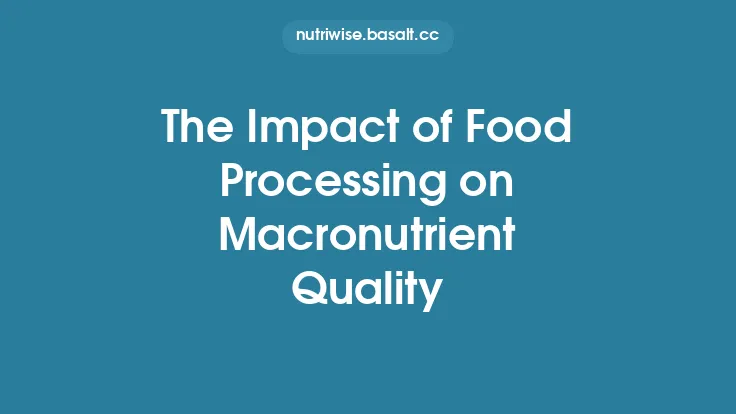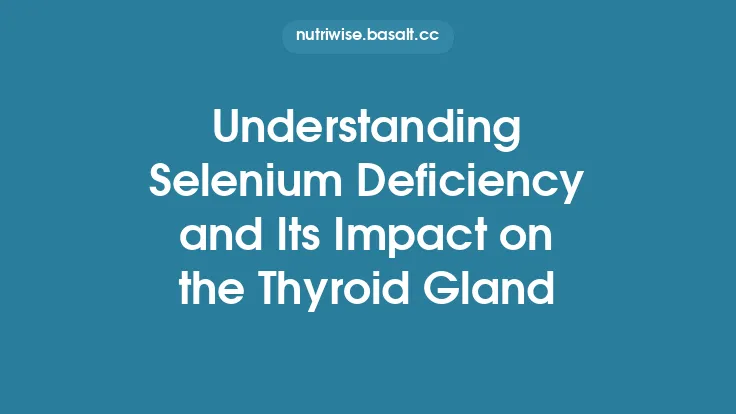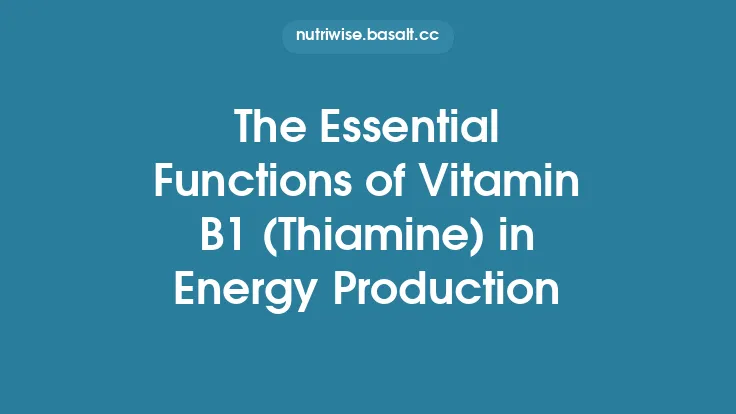Cellular energy production is a cornerstone of every physiological process, from muscle contraction to neurotransmission. While macronutrients such as carbohydrates, fats, and proteins provide the primary substrates for ATP generation, a suite of trace elements operates behind the scenes as indispensable cofactors, structural stabilizers, and regulatory agents within the mitochondria and related metabolic pathways. Understanding how these micronutrients interact—both individually and in concert—offers a deeper appreciation of the biochemical choreography that sustains life.
The Mitochondrial Powerhouse: A Brief Overview
Mitochondria are double‑membrane organelles that convert the chemical energy stored in nutrients into adenosine triphosphate (ATP) through oxidative phosphorylation (OXPHOS). The process can be distilled into three core stages:
- Substrate Oxidation – Glycolysis, β‑oxidation, and the tricarboxylic acid (TCA) cycle generate reduced electron carriers (NADH, FADH₂).
- Electron Transport Chain (ETC) – Electrons from NADH and FADH₂ travel through a series of protein complexes (I–IV) embedded in the inner mitochondrial membrane, creating a proton gradient.
- ATP Synthase Activity – The proton motive force drives ATP synthase (Complex V) to phosphorylate ADP, yielding ATP.
Each of these stages relies on trace elements that serve as prosthetic groups, catalytic centers, or structural stabilizers. When the availability or balance of these micronutrients is disrupted, the efficiency of ATP production can decline, leading to fatigue, impaired organ function, and a host of metabolic disorders.
Iron: The Central Player in Electron Transfer
Role in the ETC
Iron is perhaps the most critical trace element for cellular respiration. It is incorporated into heme groups and iron‑sulfur (Fe‑S) clusters, which are integral components of Complexes I, II, and III, as well as cytochrome c. These iron‑containing prosthetic groups facilitate the stepwise transfer of electrons, minimizing energy loss.
Regulation of Iron Homeostasis
Cellular iron levels are tightly regulated by the iron‑responsive element/iron‑regulatory protein (IRE/IRP) system. When iron is scarce, IRPs bind to IREs on mRNA transcripts, reducing translation of iron‑dependent proteins and increasing expression of iron importers (e.g., transferrin receptor). Conversely, excess iron triggers ferritin synthesis for safe storage, preventing oxidative damage.
Synergistic Interactions Within the Mitochondrion
Iron does not act in isolation. Its incorporation into Fe‑S clusters requires the coordinated activity of copper‑dependent enzymes (e.g., cytochrome c oxidase) and manganese‑dependent superoxide dismutase (MnSOD) to mitigate reactive oxygen species (ROS) generated during electron flow. This interdependence underscores the necessity of balanced trace element status for optimal ETC function.
Copper: The Gatekeeper of Complex IV
Catalytic Function in Cytochrome c Oxidase
Copper ions occupy two distinct sites (Cu_A and Cu_B) within Complex IV (cytochrome c oxidase). Cu_A accepts electrons from cytochrome c, while Cu_B participates in the reduction of molecular oxygen to water—a reaction that completes the electron transport chain and sustains the proton gradient.
Copper‑Mediated Assembly of ETC Complexes
The assembly of Complex IV is a copper‑dependent process mediated by chaperone proteins such as COX17, SCO1, and SCO2. Deficiencies in these chaperones or copper itself can lead to incomplete complex formation, resulting in reduced ATP output and accumulation of upstream electron carriers, which may increase ROS production.
Interplay with Iron
Copper and iron share a reciprocal relationship: copper deficiency can impair iron mobilization from storage sites, while excess iron can displace copper from its binding sites, compromising Complex IV activity. Maintaining an appropriate copper‑to‑iron ratio is therefore essential for seamless electron transfer.
Zinc: Modulator of Mitochondrial Enzymes and Signaling
Structural Role in Enzymes
Zinc stabilizes the tertiary structure of numerous mitochondrial enzymes, including those involved in the TCA cycle (e.g., aconitase) and the regulation of ATP synthase. Although zinc does not directly participate in electron transfer, its presence ensures proper enzyme conformation and catalytic efficiency.
Regulation of Mitochondrial Gene Expression
Zinc‑finger transcription factors, such as mitochondrial transcription factor A (TFAM), are pivotal for mitochondrial DNA replication and transcription. Adequate zinc levels support the synthesis of mitochondrial proteins, including ETC components, thereby indirectly influencing ATP production.
Antagonistic Balance with Copper
High intracellular zinc can competitively inhibit copper absorption via the metallothionein pathway, potentially leading to secondary copper deficiency. Conversely, copper excess can suppress zinc uptake. This antagonism highlights the need for balanced intake to avoid inadvertent impairment of oxidative phosphorylation.
Manganese: Guardian of Mitochondrial Redox Homeostasis
Manganese‑Dependent Superoxide Dismutase (MnSOD)
MnSOD resides in the mitochondrial matrix, converting superoxide radicals (O₂⁻) generated during electron transport into hydrogen peroxide (H₂O₂), which is subsequently reduced to water by glutathione peroxidase. By curbing oxidative stress, MnSOD preserves the integrity of ETC complexes and sustains ATP synthesis.
Cofactor for Metabolic Enzymes
Manganese also serves as a cofactor for enzymes such as pyruvate carboxylase, which replenishes oxaloacetate for the TCA cycle, and arginase, which influences nitric oxide production—a modulator of mitochondrial respiration.
Synergy with Other Trace Elements
The activity of MnSOD is enhanced when copper‑containing superoxide dismutase (Cu/Zn‑SOD) in the cytosol efficiently removes superoxide before it reaches the mitochondria. This cross‑compartmental cooperation underscores a broader network of trace element interactions that safeguard cellular energy production.
Selenium: Fine‑Tuning the Antioxidant Defense
Selenoproteins in Mitochondria
Selenium is incorporated into selenocysteine residues of several selenoproteins, notably glutathione peroxidase (GPx) and thioredoxin reductase. Within mitochondria, GPx reduces hydrogen peroxide and lipid hydroperoxides, preventing oxidative damage to membrane lipids and ETC proteins.
Impact on ATP Yield
By limiting oxidative modifications of ETC components, selenium preserves the efficiency of electron flow and proton pumping, directly influencing the amount of ATP generated per molecule of substrate oxidized.
Interaction with Copper and Iron
Excess copper can catalyze the formation of hydroxyl radicals via the Fenton reaction, overwhelming selenium‑dependent antioxidant systems. Adequate selenium thus acts as a counterbalance, ensuring that copper‑mediated electron transport does not become a source of deleterious ROS.
Chromium: Modulator of Cellular Energy Utilization
Enhancement of Insulin Signaling
Chromium potentiates the action of insulin by facilitating the translocation of glucose transporter type 4 (GLUT4) to the cell membrane. Improved glucose uptake supplies the mitochondria with a steady influx of pyruvate, feeding the TCA cycle and augmenting ATP production.
Influence on Mitochondrial Biogenesis
Emerging evidence suggests that chromium can upregulate peroxisome proliferator‑activated receptor gamma coactivator‑1α (PGC‑1α), a master regulator of mitochondrial biogenesis. An increased mitochondrial mass expands the cellular capacity for oxidative phosphorylation.
Synergistic Considerations
While chromium’s primary role lies in metabolic signaling rather than direct enzymatic catalysis, its effects are amplified when paired with adequate iron (for hemoglobin‑mediated oxygen delivery) and copper (for efficient ETC operation). A deficiency in any of these elements can blunt chromium’s capacity to enhance energy production.
Cobalt: The Core of Vitamin B₁₂ and Mitochondrial Metabolism
Cobalamin‑Dependent Enzymes
Cobalt is the central atom of vitamin B₁₂ (cobalamin), which serves as a cofactor for two critical mitochondrial enzymes:
- Methylmalonyl‑CoA Mutase – Converts methylmalonyl‑CoA to succinyl‑CoA, feeding the TCA cycle.
- Methionine Synthase – Regenerates methionine from homocysteine, supporting S‑adenosyl‑methionine (SAM) synthesis, a methyl donor for mitochondrial DNA methylation and gene expression.
Impact on Energy Yield
By ensuring the proper flow of carbon skeletons into the TCA cycle, cobalt‑dependent B₁₂ maintains a robust supply of NADH and FADH₂ for the ETC, thereby sustaining high ATP yields.
Interdependence with Other Micronutrients
Vitamin B₁₂ absorption requires intrinsic factor and adequate folate (a B‑vitamin) status. While folate is not a trace element, its interaction with B₁₂ illustrates the broader principle that micronutrient networks—both trace and non‑trace—must be balanced for optimal mitochondrial function.
Integrated Perspective: How Trace Elements Orchestrate Cellular Energy
- Cofactor Provision – Iron, copper, manganese, and cobalt directly embed within mitochondrial enzymes, enabling electron transfer, substrate oxidation, and ATP synthesis.
- Structural Stabilization – Zinc and selenium maintain the three‑dimensional integrity of proteins and protect them from oxidative damage.
- Redox Regulation – MnSOD, GPx, and other selenoproteins neutralize ROS, preserving the functional lifespan of ETC complexes.
- Metabolic Signaling – Chromium enhances insulin‑mediated glucose uptake, while cobalt (via B₁₂) ensures the smooth entry of carbon units into the TCA cycle.
- Cross‑Element Synergy – The efficiency of one trace element often hinges on the presence of another (e.g., copper‑dependent Complex IV requires iron‑sulfur clusters; MnSOD activity is complemented by cytosolic Cu/Zn‑SOD).
When any component of this network is deficient, excess, or imbalanced, the ripple effect can diminish mitochondrial efficiency, lower ATP output, and increase susceptibility to metabolic fatigue.
Practical Implications for Maintaining Optimal Trace Element Status
- Diverse Food Sources – Incorporate a variety of animal and plant foods to cover the spectrum of trace elements: red meat and shellfish (iron, copper, zinc, cobalt), whole grains and legumes (manganese, chromium), nuts and seeds (selenium), and dairy or fortified products (vitamin B₁₂).
- Avoiding Competitive Inhibition – High doses of a single supplement (e.g., zinc megadoses) can impede the absorption of others (copper, iron). Aim for balanced supplementation when needed, guided by laboratory assessments.
- Monitoring Clinical Indicators – Serum ferritin, ceruloplasmin, zinc, copper, and selenium levels, along with functional markers such as cytochrome c oxidase activity, can help identify subclinical deficiencies that may affect energy metabolism.
- Consideration of Life‑Stage Demands – Pregnancy, growth periods, and aging alter trace element requirements; tailored intake ensures that mitochondrial capacity keeps pace with physiological demands.
Concluding Thoughts
The production of cellular energy is a finely tuned symphony in which trace elements serve as essential musicians. Iron and copper conduct the flow of electrons through the electron transport chain, while manganese and selenium safeguard the performance from oxidative mishaps. Zinc and chromium fine‑tune the structural and signaling aspects, and cobalt, via vitamin B₁₂, ensures that the metabolic substrates are properly channeled into the cycle. Their combined impact transcends the sum of individual contributions, illustrating a sophisticated web of interdependence that underlies every heartbeat, thought, and movement.
By appreciating and maintaining the delicate balance of these micronutrients, we support the mitochondria’s capacity to generate the ATP that fuels life itself—an evergreen principle that remains relevant across health conditions, ages, and lifestyles.
